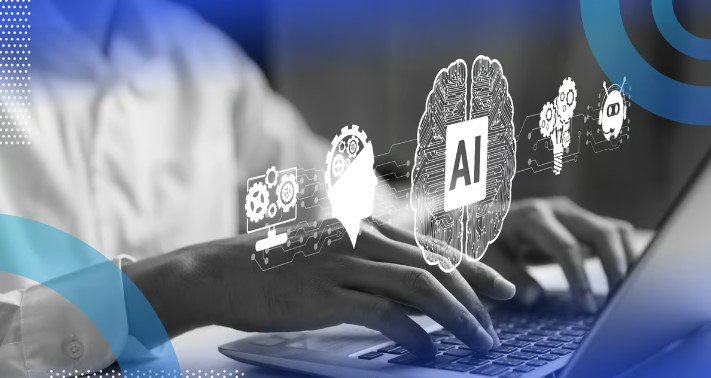The implementation of smart assistants and predictive analytics technologies is reshaping workplace productivity as AI impacts every industry.
San Francisco, CA – The notion of AI as anything other than a futuristic idea used in tech fiction or advanced laboratories has shifted into a main driving force of productivity in offices, warehouses, hospitals, and farms. Startups and global companies are investing in AI with the hopes of improving operational productivity and providing advanced tools for employees to utilize AI alongside other smart systems.
The main concern that professionals struggle with is how AI is useful in achieving quantifiable business tasks. The following will illustrate how work has changed in modern days to help professionals stay ahead of the trend.
1. Removing Manual Procedures
Automation is the most direct use of AI in increasing productivity. Repetitive tasks like data entry, scheduling, and invoicing can be performed quickly and accurately by bots and software integrated with AI.
The usage of RPA (Robotic Process Automation) technologies, which claim high accuracy in automation of invoice processing, form filling, scheduling, and many wide range of office activities. UIPath and Automation Anywhere, alongside Blue Prism, are companies that work to integrate advanced technology seamlessly into corporate workflows.
“We’ve saved over 2,000 manhours annually just by automating onboarding and payroll.”
2. This chapter is concerned with the improvement of organizational efficiency and decision-making processes with the help of predictive analytics. Added in their place of employment, indicate forecasting as a part of predictive analysis.
AI-driven predictive analytics with integrated machine learning algorithms analyze large volumes of data and provide foresight that aids in improving the speed and quality of decision-making.
AI is employed in finance to predict future market opportunities. Similarly, in retail, it is utilized to predict stock levels, while logistics employs certain forecasting models to mitigate delays and reduce operational bottlenecks.
For example, *Amazon* utilizes this technology to anticipate customer needs, enabling the well-known “1-click” order feature, which requires preemptive warehouse stocking.
*“The AI does not only show us the data – it tells us what’s bound to happen next,”* reflects Diego Morales, Data Analyst at a shipping startup in Latin America.
3. ChatGPT, Gemini, and other tools as virtual AI Assistants
*“The AI does not only show us the data – it tells us what’s bound to happen next,”* reflects Diego Morales, Data Analyst at a shipping startup in Latin America.
All Order cannot only suggest meal plans for the week, but they can also chat, debate, and provide us with an innumerable number of dialogues, pushing the boundaries of coherence and logic.
According to McKinsey & Company, AI applications can reduce time spent on administrative duties by 40% across multiple industries, including customer service, legal research, and marketing, showcasing the profound impact such technologies have on productivity.
“I rely on AI for the initial draft of nearly every email and blog post,” stated Priya Nair, a content strategist based in New York. “This way, I can concentrate on polishing the message instead of sweating over the first draft.”
4. Meeting Optimizer and Smart Calendar Scheduler
AI has made significant strides in time management. Tools such as Clockwise, Reclaim, and Motion leverage AI to restructure your calendar dynamically. They block focus time, schedule meetings, and attend to other tasks based on urgency.
AI applications evaluate individual work behaviors to suggest optimal meeting times, prevent burnout, enhance team cooperation, even across time zones.
For example, consider a group of remote workers located in Tokyo, Berlin, and Toronto. AI scheduling tools can optimize meeting times with the least amount of fatigue for everyone involved.
5. Recruitment and HR Simplification
AI is transforming recruitment by eliminating biases, unifying the hiring cycle, and improving matching efficiency. Companies such as HireVue and Pymetrics analyze a candidate’s resume alongside their facial and voice features to pick the best matches.
At the same time, chatbots such as Paradox Olivia are answering candidate questions and screening applications outside of office hours, reducing the hiring period by up to 60%.
AI is also employed to gauge staff sentiment, recommend personalized learning experiences, and predict attrition risks based on behavioral analysis within an organization.
“Employees who are predicted to leave were flagged for us by the system with an 80% accuracy rate,” stated Maira Delgado, Head of People Analytics at an international IT company.
6. Tailored Learning and Upskilling Initiatives
Learning and productivity need to keep pace continuously, especially in the modern workplace. AI technologies such as those embedded in Coursera for Business, LinkedIn Learning, and EdCast offer custom training in the form of courses tailored to individual roles, objectives, and skill deficits.
Such platforms offer dynamic blended learning that adapts to the user’s pace. Learning assessments, practice tasks, and content referrals are aligned with the users’ business goals.
“It’s like having a personal tutor skin-deep if it were a digital one—who has access to every single document and files within the company,” said Nikhil Arora, an instructional designer at a tech firm based in Mumbai.
7. Enhanced Customer Care
Customer satisfaction has seen a tremendous boost thanks to AI chatbots and voice assistants who can answer queries in record time. Zendesk, Drift, and Freshdesk have AI modules that respond to tickets, propose answers to human agents, and even analyze the tone and level of concern expressed in the messages.
Such bots are powered by Natural Language Processing (NLP), which enables them to understand questions and respond appropriately, as well as pass on questions to human agents where necessary.
The technology enables companies to provide round-the-clock support without draining their human resources.
8. Collaborative Creativity and Idea Development
In marketing, video production, music, and even journalism, professionals are using AI as a co-creator. Adobe Firefly, Runway ML, and Lumen5 are tools that suggest AI and automation to make content creation quicker.
With the aid of generative AI, designers can create mood boards, transform sketches into fully graphic images, and script videos in under a few minutes.
“Now, instead of requiring an entire week to storyboard and prototype, one can accomplish it within a single afternoon,” shared Jennifer Liu, Creative Director at a media company based in Los Angeles.
9. Goal Monitoring with Intelligence-Based Data
Notion AI, ClickUp, and Asana Intelligence offer tracking goals AI features to users as embedded AI in the platforms.
Management is only one factor these tools offer—in addition, they proactively alert users of important deadlines and overdue tasks, recommend new assignments, and even create visual representations of productivity over time.

Steps to Follow
Boosting productivity when using AI does not require substantial financial resources or a technical team. Here’s a framework for how individuals and organizations can get started:
Focus on gaps in productivity for workflow bottlenecks as they provide the best opportunities for automation.
Select AI applications that are relevant to your objectives, such as writing, scheduling, or even data analytics, to fully meet your expectations.
Encourage your team to learn how to collaborate with AI systems rather than oppose working with the technology.
Scale up gradually after starting small and measuring improvements.
Stay ethical— avoid using AI tools that promote bias, invade privacy, or substitute human empathy.
Table of Contents
Final Thoughts
There is no doubt that the productivity potential of AI is already transforming how we work. From freelancers managing several clients to CEOs running multinational companies, AI has the ability to make users more efficient, precise, and focused, impacting every industry.
As companies continue to adapt, using AI for business will give a huge competitive advantage.



